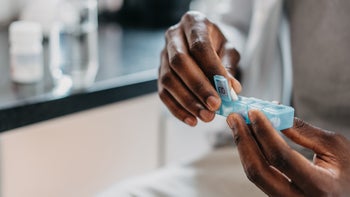
8 Litfulo Side Effects and How to Manage Them
Key takeaways:
Litfulo (ritlecitinib) is an oral medication that’s prescribed to treat alopecia in adults and kids ages 12 and older. It works by blocking immune proteins called Janus kinase and tyrosine kinase.
Common Litfulo side effects include headache, diarrhea, and changes in lab work. Skin rashes and acne are also possible.
Rare but serious Litfulo side effects include serious infections, blood clots, and heart attack or stroke. Your healthcare professional should assess your risk for these side effects and help you prevent or manage them.
Table of contents

If you are living with alopecia areata, you’re well aware of how hair loss can cause emotional, physical, and social challenges. This condition can cause patchy hair loss on the scalp, but it may affect any area of the body that has hair.
A few alopecia medications are available to help reverse some of these changes. But you may be prescribed Litfulo (ritlecitinib) if other treatments haven’t worked. Litfulo is the first once-daily oral medication FDA approved to treat severe alopecia areata in adults and kids ages 12 and older. Similar medications are approved for use in adults only. Litfulo works by blocking Janus kinase (JAK) and tyrosine kinase — immune proteins that attack hair follicles. By blocking these proteins, Litfulo calms down the immune system, which may allow your hair to regrow.
Litfulo is beneficial for many people. But it has several potential side effects. Most are mild and manageable, but serious side effects are possible. If you have been prescribed Litfulo, knowing what to watch for is helpful.
Litfulo side effects at a glance
Some of Litfulo’s side effects are mild and can be managed at home, while others are serious and may require medical attention.
Common Litfulo side effects include:
Headache
Diarrhea
Acne
Rash
Hives
Mouth sores
Inflamed hair pores
Altered laboratory values
Less common but potentially serious risks include:
Severe infection
Increased risk of cancer
Heart problems
Blood clots
Allergic reactions
We’ll discuss what you need to know about the eight notable Litfulo side effects and how you can manage them.
Knowing what to expect: Read about one person’s experience living with alopecia areata.
Weighing your options: Learn about the alopecia treatments available and how they compare with newer medications in clinical trials.
Managing diarrhea: Small changes in your diet can make a big difference. Find out what foods to avoid and what you can eat instead.
1. Headache
Headaches are the most common Litfulo side effect. These include migraines and general head discomfort. Keep in mind, headaches have many possible causes besides medication. These include not getting enough sleep, being overly stressed, and not drinking enough water. Certain food and health conditions can also cause headaches.
It can be difficult to know if your headaches are caused by Litfulo or something else. But there are many things you can try to get some relief. Staying hydrated throughout the day and getting enough sleep may help treat and prevent headaches. Routine exercise and stress reduction can also make a difference.
If headaches become hard to manage, ask your pharmacist for an over-the-counter (OTC) pain medication that’s safe for you to take. Common OTC headache treatments include ibuprofen (Motrin, Advil) and acetaminophen (Tylenol).
2. Diarrhea
Diarrhea is another common Litfulo side effect. Thankfully, there are ways to manage diarrhea at home.
Temporary diet changes can help solve milder cases of diarrhea. Try to avoid spicy, greasy, and fried foods. Avoid high-fiber foods, such as broccoli, legumes, and oatmeal, since they can make diarrhea worse. Try to prioritize bland foods such as bananas, applesauce, and toast. These should be easier on your stomach. Staying hydrated is also important to prevent dehydration if you experience persistent diarrhea.
OTC antidiarrhea medications, such as loperamide (Imodium A-D), may also be helpful. But it’s recommended to check with your healthcare professional before trying one. They can tell you if it’s safe for you to take one. They may recommend a different treatment if your diarrhea has lasted longer than 2 days or you have bloody stools, among other reasons.
3. Acne
Acne is a possible side effect of many JAK inhibitors, including Litfulo. Mild cases of acne should gradually go away on their own. But if you continue to experience acne, a few things may help clear up your skin.
Diets low in sugar and good skin care hygiene can help prevent further acne formation. Topical OTC medications, such as adapalene (Differin) or salicylic acid, can also help clear up acne.
Contact your dermatologist if your acne gets worse or won’t go away. Depending on how severe your symptoms are, they may recommend a prescription acne treatment, such as tretinoin (Retin-A) or isotretinoin (Claravis).
4. Rashes, folliculitis, and hives
Many medications, including Litfulo, can cause skin rashes or hives as a side effect. Litfulo may also cause inflamed and infected hair follicles (folliculitis).
If you experience a skin rash or hives after starting Litfulo, let your healthcare professional know right away. They may want to watch the rash closely or tell you to stop taking Litfulo. This is because getting a skin rash while taking Litfulo may be a sign of an allergic reaction. You may see a mild skin rash accompanied by hives at first, but this could progress. If you experience trouble breathing or swelling of the face, lips, or tongue, go to the emergency room.
Folliculitis causes bumps that look similar to acne, and the bumps may be full of pus. If you develop folliculitis after starting Litfulo, contact your healthcare professional. They may prescribe an antibiotic cream or pill.
5. Mouth sores
Mouth sores are another potential Litfulo side effect. You may also develop redness and swelling in the lining of your mouth. These oral symptoms can be painful and make it hard to eat and drink.
If your symptoms are bothersome, a few things you can try to get some relief include:
Avoiding alcohol and mouthwashes that contain alcohol
Avoiding salty, spicy, and hard-to-chew foods
Sucking on ice cubes
Rinsing your mouth with salt water and baking soda
Taking OTC pain medications (e.g., ibuprofen and acetaminophen)
If mouth sores become unmanageable, contact your healthcare professional. They may be able to recommend a prescription mouth rinse, such as magic mouthwash, to address the discomfort.
6. Changes to your lab work
Certain changes to your blood cell counts are possible while taking Litfulo. This includes low white blood cells (cells that fight infections) and low platelets (cells that stop bleeding). These changes can increase your risk of infection and bleeding, respectively.
Your healthcare professional will likely analyze your bloodwork before starting Litfulo and every 4 weeks while taking it. If your blood counts are critically out of range, they may ask you to stop taking Litfulo temporarily or altogether.
Litfulo can also increase your liver enzyme levels. Liver enzymes are proteins that help the liver perform its job. When liver enzyme levels are increased, there may be a problem with the liver. Your healthcare professional will likely check these blood tests before you start Litfulo and at certain points during your treatment. If your liver enzyme levels are dangerously out of range, they may ask you to stop taking Litfulo.
Litfulo can also raise your blood creatine phosphokinase (CPK) levels. Though rare, high CPK levels can be a sign of severe muscle damage called rhabdomyolysis. Your healthcare professional might stop your treatment if you have very high CPK levels or if you have symptoms such as unexplained muscle pain, muscle stiffness, or dark urine.
7. Serious infection and cancer
Litfulo lowers your body’s ability to fight infections. Infections from bacteria and viruses were occasionally reported in Litfulo’s clinical trials. Serious infections, including tuberculosis and shingles, are also possible.
It’s important to let your healthcare professional know if you have signs or symptoms of an infection before or during Litfulo treatment. These symptoms include fever, chills, or a new or worse cough. If you have an active infection, you shouldn’t take Litfulo. You may also need to avoid Litfulo if you have a history of serious or recurrent infections or a health condition that raises your risk of infection.
An increased risk of certain cancers is another rare side effect of Litfulo. In clinical studies, cases of lung cancer and lymphoma were observed in some people taking other JAK inhibitors. The risk is higher for people who smoke or have smoked in the past.
Certain types of skin cancer have also been reported with Litfulo. Wearing sunscreen and protective clothing and using an umbrella can decrease your risk of skin cancer. Your healthcare professional can help determine your overall cancer risk. They may also recommend regular skin checks to look for signs or symptoms of skin cancer while taking Litfulo.
8. Heart complications
People who take JAK inhibitors, such as Litfulo, have a higher risk of developing heart problems. This includes heart attack, stroke, and heart-related death in severe cases. Blood clots in your arms, legs, and lungs are also possible.
These complications are rare. But they’re serious risks to keep in mind. The risk for heart problems is higher in adults who are 50 and older with one or more heart disease risk factors, such as diabetes, high blood pressure, and high cholesterol. This risk is also increased with heavy alcohol use and for current and former smokers.
If you’re at high risk for developing heart problems, your healthcare professional may prescribe a different alopecia medication out of caution.
The bottom line
Common Litfulo (ritlecitinib) side effects include headache, diarrhea, and mouth sores. Skin rashes, hives, and changes to your lab work can also happen. Rare but serious side effects include a higher risk for certain cancers, blood clots, and heart attack and stroke. Talk with your healthcare professional about how to manage or prevent Litfulo’s side effects.
Why trust our experts?



References
American Cancer Society. (2021). Mouth sores and pain.
Blair, H. A., et al. (2023). Ritlecitinib: First approval. Drugs.
MedlinePlus. (2023). Creatine kinase.
Pfizer. (2023). FDA approves Pfizer’s Litfulo (ritlecitinib) for adults and adolescents with severe alopecia areata.
Pfizer Laboratories Div Pfizer. (2023). Litfulo- ritlecitinib capsule [package insert].
Roskoski, R., Jr. (2024). Properties of FDA-approved small molecule protein kinase inhibitors: A 2024 update. Pharmacological Research.
Winters, R.D., et al. (2023). Folliculitis. StatPearls.
Was this page helpful?
Related Articles
Browse medications
View AllResearch prescriptions and over-the-counter medications from A to Z, compare drug prices, and start saving.


